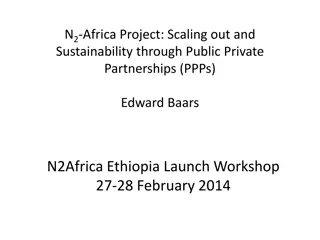
Cultural Factors in Public-Private Partnerships: Do Firms Benefit?
This study explores the impact of national cultural values on firms involved in Public-Private Partnerships (PPPs). It delves into whether assertiveness and performance orientation, typically beneficial in businesses, may hinder firms in PPPs. The research investigates potential conflicts between cultural values and the cooperative nature of PPPs, offering insights into the management of partnerships for achieving Sustainable Development Goals.
Download Presentation

Please find below an Image/Link to download the presentation.
The content on the website is provided AS IS for your information and personal use only. It may not be sold, licensed, or shared on other websites without obtaining consent from the author. If you encounter any issues during the download, it is possible that the publisher has removed the file from their server.
You are allowed to download the files provided on this website for personal or commercial use, subject to the condition that they are used lawfully. All files are the property of their respective owners.
The content on the website is provided AS IS for your information and personal use only. It may not be sold, licensed, or shared on other websites without obtaining consent from the author.
E N D
Presentation Transcript
Cultural Factors Shaping Institutions: Do Firms Benefit in Public-Private Partnerships? Dr. Deborah de Lange Ted Rogers School of Management Ryerson University 2018
Contents Background/Rationale Significance Research Question Cultural Factors Shaping Institutions: Do Firms Benefit in Public-Private Partnerships? Theory Hypotheses Methods Results Discussion Conclusions
Background/Rationale For the UN SDGs, we need to know how to manage partnerships #1 Consider the main effects Do PPPs benefit firms?: An initial assumption is that a firm in PPPs has lucrative work with the government (Berrios, 2006). So, PPP opportunities would be associated with more success and employment in these firms (larger firms). A firm must hire to satisfy the requirements of PPP work. However, it is not clear whether PPP involvement is necessarily good for a firm, given a lack of research on this topic. Do assertive and performance oriented national cultures support firms?: Is an assertive and/or performance oriented national culture associated with larger firms? Some research suggests that these correlated values are associated with business success (Rauch, et al., 2013), but previous research has not specifically tested the relationship in this research.
Background/Rationale For the UN SDGs, we need to know how to manage partnerships #2 Consider the interactions National cultural values in a PPP: We do not know whether national cultural values affect firms involved in PPPs, in general. Consider assertive and performance oriented national culture values: Will a firm in this type of cultural environment and involved in PPPs tend to be larger as a result? These types of values could be in conflict with the cooperation/patience that is required in PPPs requiring coordination (O Leary and Vij, 2012), and/or PPPs could be inertial institutions that do not respond well to these values - so firms may not do better under these circumstances (Stal, 2015).
Practical Significance For the UN SDGs, we need to know how to manage partnerships Management of PPPs: This research informs the management of PPPs, considering national culture variables, and firms decisions about whether and/or when to be involved in PPPs. The success of transportation PPPs, which are reliant on partner firms successes, enable SDGs related to infrastructure, cities, responsible production and consumption, and climate action.
Research Question Do national cultural values of assertiveness and performance orientation which are expected to support a transportation firm, instead diminish the same firm in public private partnerships (PPPs)?
Theory Combine institutional and international business theories, and inform the literature on sustainable development, PPPs, and transportation. Posit that national culture enters into institutions: Examine whether national culture affects institutions and firms participating in institutions such as PPPs. PPPs are institutions made up of partnering organizations from the public and private sectors (Bradford, 2003; Peters, 1998; Samii, Van Wassenhove, & Bhattacharya, 2002). Institutional theory considers mechanisms leading to isomorphism such as cultural-cognitive, normative, and regulative factors (DiMaggio & Powell, 1983; DiMaggio, 1997). Culture in a general sense has been part of institutional theory; research has not explored National Culture as an institutional factor. Institutional factors such as regulatory quality, market openness, ease to start a business, and contract enforcement are determinants of the success of transportation projects (Panayides, Parola,& Lam, 2015), but national culture has not been investigated as one of those factors.
Hypotheses - Explanations H1a and H1b: Assertiveness and Performance Orientation are expected to be national cultural values facilitative of business so firms operating within national cultures having these values will be larger (Rauch, et al., 2013). Also, some previous research in entrepreneurship implies that performance-focused and assertive cultures may hold back small firms needing social capital support (Stephan & Uhlaner, 2010) thus, larger firms may benefit under these circumstances. H2a and H2b: PPPs are posited as beneficial for the firms that engage in them because they are lucrative business opportunities working with government actors. Firms will need more employees to work on these large public projects. Variables include PPP = having a PPP and Number of PPPs = increasing number of PPPs . H3a-H3d Interactions: Interact national cultural factors with having a PPP(s). National cultural factors normally fostering the independent success of firms (as predicted) may not facilitate partnerships so the combination may negatively affect firm size.
Methods Data: International sample of 300 transportation firms from Crunchbase; Firms are in 26 countries across continents. Context: The transportation PPP setting is opportune for this investigation; transportation firms are often private, but work on public infrastructure with public institutions interwoven with national culture (Rob rt, 2017). National Culture Dimensions: coding sourced from the GLOBE data on national societal values (House et al., 2004). PPP data: World Bank report (IBRD, 2017). DV: Size of a transportation firm - number of employees IVs: Assertive Orientation, Performance Orientation, PPP, Number of PPPs Model: Negative binomial re: over dispersion in the dependent variable [Variance >> Mean] Hierarchical regression with controls (Firm Age, Total Funding Amount; Country Dummy to control for other national factors)
Data Description Correlations & Basic Statistics Pairwise Correlations Performance Orientation Societal Values Firm Size Category Firm Age 1 0.19 0.35 0.35 0.4 -0.13 0.18 -0.02 Total Funding Amount Number of PPPs Assertiveness Societal Values Country Dummy PPP Firm Size Category Firm Age TotalFundingAmount PPP NumberOfPPPs Performance Orientation Societal Values Assertiveness Societal Values Country Dummy VARIABLES Firm Age Firm Size Category Total Funding Amount Country Dummy PPP Number of PPPs Performance Orientation Societal Values Assertiveness Societal Values 1 0.01 0.07 0.13 0.03 0.08 0.04 1 0.19 0.43 0.02 0.08 0.03 N 300 300 300 300 300 300 300 300 1 0.71 0.01 0.07 0.06 1 -0.04 0.07 0.05 1 0.48 0.48 1 0.34 1 mean 9.740 1.130 9.76e+07 22.72 0.187 0.397 6.050 4.151 sd min 0 0 0 1 0 0 4.917 2.833 max 147 8 15.48 1.758 7.48e+08 8.553 0.390 1.176 0.180 0.427 1.16e+10 28 1 10 6.398 5.442
Results VARIABLES (1) (2) (3) (4) (5) Firm Age 0.0149*** -0.0046 1.99e-10** -8.54E-11 0.821*** -0.224 0.00451 -0.0727 -0.0727 0.0166*** -0.00473 2.56e-10*** -9.46E-11 14.64*** -4.983 -0.00867 -0.0752 0.0166*** -0.00476 2.66e-10*** -9.53E-11 0.785*** -0.229 2.956** -1.281 0.0145*** -0.00474 2.07e-10** -9.83E-11 4.822*** -1.482 0.0657 -0.0719 0.0149*** -0.00483 1.91e-10* -9.79E-11 0.706*** -0.235 1.042** -0.421 Total Funding Amount PPP Models with DV: Firm Size Category 0.821*** -0.224 0.00451 PPP Number of PPPs Number of PPPs Performance Orientation Performance Orientation Societal Values Societal Values -1.573*** -0.488 -1.573*** -0.488 0.725*** -0.185 0.0044 -0.0104 0.0992 -0.575 -0.155 -0.543 Assertiveness Societal Values Assertiveness Societal Values 0.858*** -0.217 -0.0143 -0.00874 0.750*** -0.201 -0.0164* -0.00892 0.725*** -0.185 Country Dummy Performance Orientation Societal Values X PPP -0.00188 -0.0103 -0.00289 -0.0103 Performance Orientation Societal Values X PPP -2.288*** -0.821 -2.288*** -0.821 Performance Orientation Societal Values X Number of PPPs Performance Orientation Societal Values X Number of PPPs Assertiveness Societal Values X PPP -0.490** -0.213 -0.490** -0.213 Assertiveness Societal Values X PPP -0.964*** -0.349 -0.349 -0.964*** Assertiveness Societal Values X Number of PPPs Assertiveness Societal Values X Number of PPPs -0.223** -0.0932 -3.147*** -0.84 -0.223** -0.0932 Constant 6.011** -2.62 -0.937 -3.377 0.625 -3.169 -3.646*** -0.922 Observations 300 300 300 300 300 Standard errors in parentheses *** p<0.01, ** p<0.05, * p<0.1
Results Summary Hypothesis Result Comments Supported; assertiveness may be necessary as a firm becomes larger and more inertial H1a Assertive Orientation +VE H1b Performance Orientation -VE Opposite result; performance orientation matches with smaller rather than larger inertial organizations where it may be futile Supported; Having had at least one PPP corresponds to larger firms. H2a PPP +VE H2b Number of PPPs NS Not supported; the result is non-significant (NS); More PPPs have no relation to size of the firm. Supported; higher significance and larger effect with PPP than Number of PPPs. This becomes negative as compared with H1a and H2a so the combination changes the outcome. H3a Assertive Orientation X PPP -VE H3b Performance Orientation X PPP -VE Supported; higher significance and larger effect with PPP than Number of PPPs. H3c Assertive Orientation X No. of PPPs -VE Supported. H3d Performance Orientation X No. of PPPs -VE Supported.
Results & Discussion The core proposition that cultural factors can have different effects in and outside of partnerships is supported. E.g., An assertive culture is aligned with larger firms and so is having at least one PPP. However, both conditions at the same time, negatively affect firm size. Findings are supportive of all of the hypotheses except: H1b (-ve when predicted +ve) Performance Orientation is not associated with larger firms which may be consistent with the entrepreneurship literature (small firms are more flexible (Bartz and Winkler, 2016) and can respond to a culture of performance). H2b (non-significant) more PPPs are not associated with a larger firm. This result needs further investigation, but it could be that there is a threshold where more PPPs have no more affect on firm size.
Conclusions What works for a firm, may not work in a public private partnership. PPPs are institutions in which national cultural factors affect participant firms. Given this evidence, studies in institutional theory should consider national cultural dimensions as potentially influencing institutional outcomes. Particularly, private transportation firms entering into PPPs, influenced by performance oriented or assertive national cultural values may expect to experience some negative effects on size. Policy makers learn that PPPs do support employment in partner firms when not considering national cultural factors. The evidence encourages firms to join PPPs but to be wary of some national cultural factors, possibly finding ways to counteract them. Reducing assertive tendencies and hard pushes for performance may improve partnership outcomes.
Selected References Aon Hewitt Inc. (2016). Developing Canada s future workforce: a survey of large private-sector employers, Business Council of Canada, March. Bartz, W., & Winkler, A. (2016). Flexible or fragile? The growth performance of small and young businesses during the global financial crisis Evidence from Germany. Journal of Business Venturing, 31(2), 196-215. Berrios, R. (2006). Government contracts and contractor behavior. Journal of Business Ethics, 63(2), 119-130. Bradford, N. (2003). Public-private partnership? Shifting paradigms of economic governance in Ontario. Canadian Journal of Political Science/Revue canadienne de science politique, 36(5), 1005-1033. Crunchbase. https://www.crunchbase.com/ DiMaggio, P. (1997). Culture and cognition. Annual Review of Sociology, 23(1), 263-287. DiMaggio, P., & Powell, W. W. (1983). The iron cage revisited: Collective rationality and institutional isomorphism in organizational fields. American Sociological Review, 48(2), 147-160. House, R. J., Hanges, P. J., Javidan, M., Dorfman, P. W., & Gupta, V. (Eds.). (2004). Culture, leadership, and organizations: The GLOBE study of 62 societies. Sage publications. IBRD (2017). Benchmarking PPP procurement: Assessing government capability to prepare, procure and manage PPPs. World Bank. Morgadinho, L., Oliveira, C., & Martinho, A. (2015). A qualitative study about perceptions of European automotive sector's contribution to lower greenhouse gas emissions. Journal of Cleaner Production, 106, 644-653.
Selected References (contd) O Leary, R., & Vij, N. (2012). Collaborative public management: Where have we been and where are we going?. The American Review of Public Administration, 42(5), 507-522. Panayides, P. M., Parola, F., & Lam, J. S. L. (2015). The effect of institutional factors on public private partnership success in ports. Transportation Research Part A: Policy and Practice, 71, 110-127. Peters, B. G. (1998). With a little help from our friends : Public-private partnerships as institutions and instruments. In Partnerships in urban governance (pp. 11-33). Palgrave Macmillan UK. Rauch, A., Frese, M., Wang, Z. M., Unger, J., Lozada, M., Kupcha, V., & Spirina, T. (2013). National culture and cultural orientations of owners affecting the innovation growth relationship in five countries. Entrepreneurship & Regional Development, 25(9-10), 732-755. Rob rt, M. (2017). Engaging private actors in transport planning to achieve future emission targets upscaling the Climate and Economic Research in Organisations (CERO) process to regional perspectives. Journal of Cleaner Production, 140, 324-332. Samii, R., Van Wassenhove, L. N., & Bhattacharya, S. (2002). An innovative public private partnership: New approach to development. World Development, 30(6), 991-1008. United Nations. 2015. St l, H. I. (2015). Inertia and change related to sustainability An institutional approach. Journal of Cleaner Production, 99, 354-365. United Nations Sustainable Development Goals https://sustainabledevelopment.un.org/?menu=1300






















